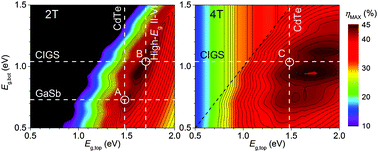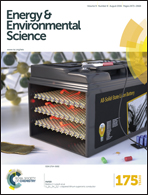Energy-yield prediction for II–VI-based thin-film tandem solar cells†
Abstract
Polycrystalline, thin-film tandem solar cells that leverage commercial II–VI semiconductor technologies as the top cell could overcome the practical conversion-efficiency limits of single-junction solar cells. However, it is unclear to what extent this class of tandems would outperform single-junction solar cells under realistic operating conditions in the field. In this paper we model the annual energy-yield of tandems with polycrystalline II–VI top cells with different band gap pairs and architectures under changing illumination spectra in different climates. We find that both two-terminal, high-band gap II–VI/CIGS and four-terminal CdTe/CIGS tandems offer energy-yield advantages in all climates commensurate with their AM1.5G efficiency improvements, up to [38%] relative. On the other hand, a two-terminal CdTe/GaSb tandem cell has only an [11%] annual energy-yield advantage in humid climate, because infrared light absorption due to atmospheric water vapor limits the bottom-cell contribution. In addition to narrowing the scope of future II–VI-based tandem R&D efforts, our methodology to rapidly assess tandem energy-yield should be easily generalizable to other material combinations.


 Please wait while we load your content...
Please wait while we load your content...